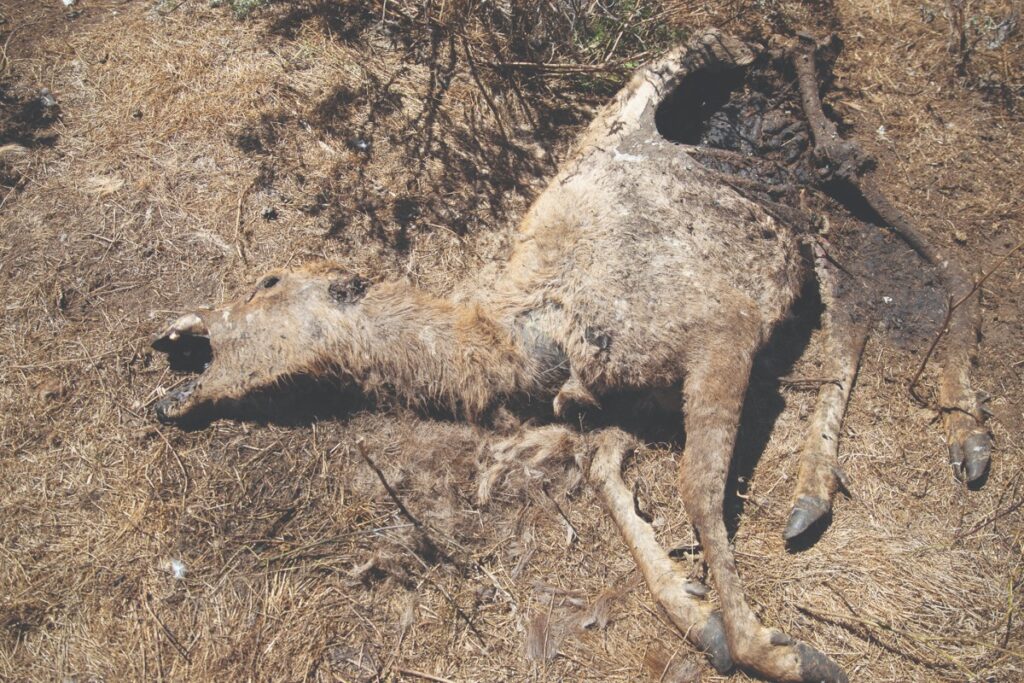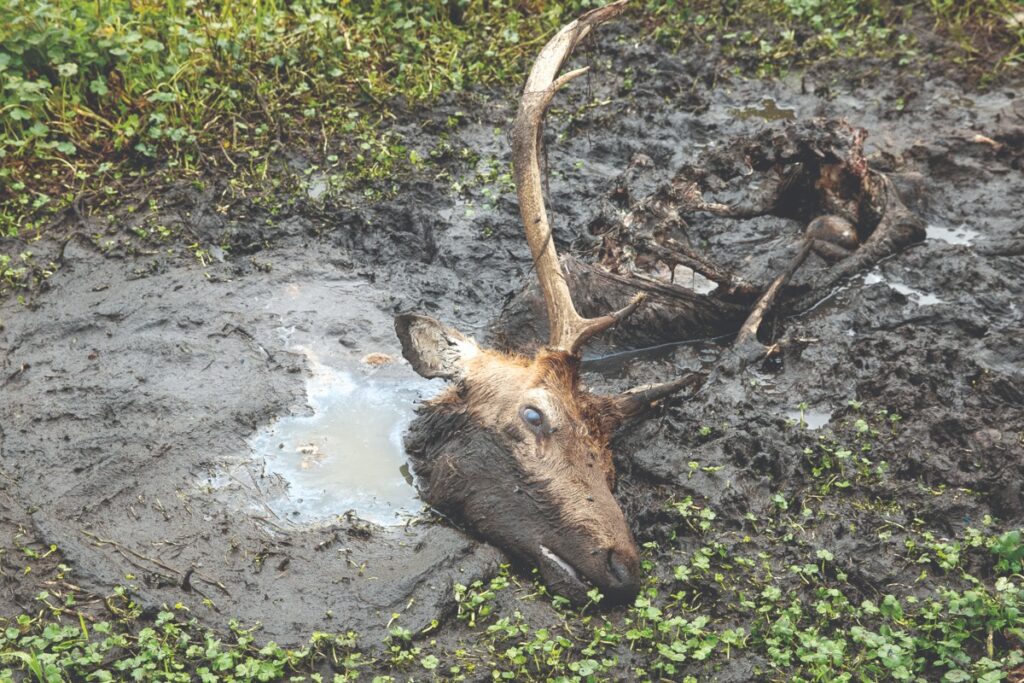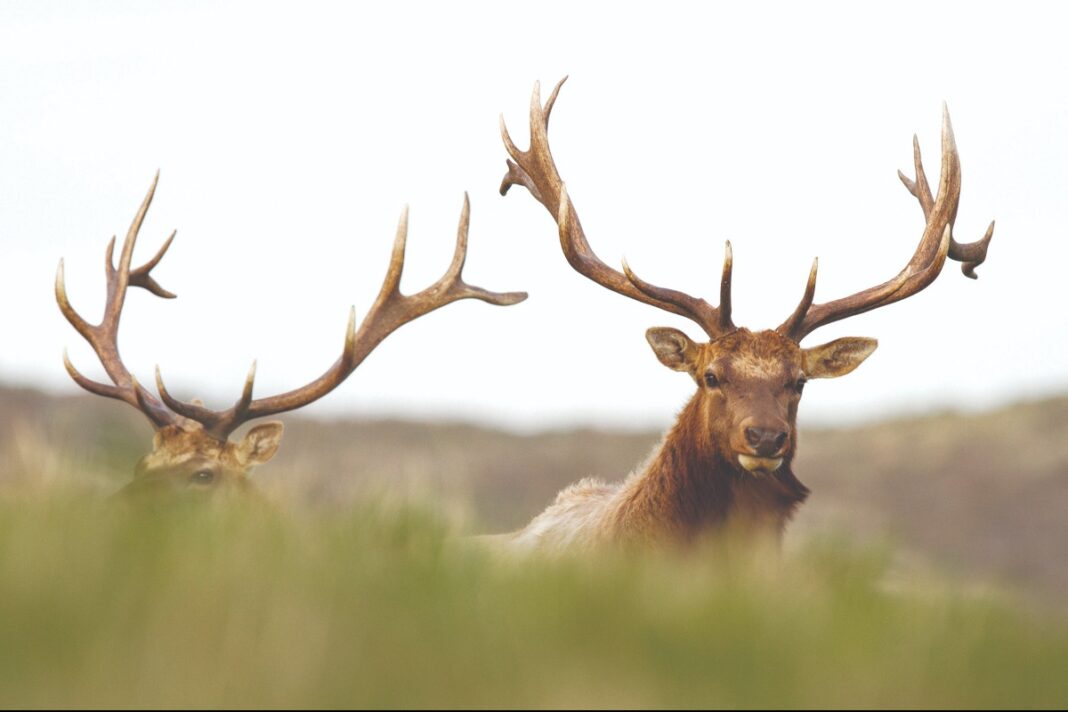Instagram users love the captive tule elk hoofing Tomales Point at the northern tip of Point Reyes National Seashore.
The sleek, befurred mammals seem to commune with tourists who stroll a well-traveled trail in the preserve. Tule elk are Yoda-like, with big, brown eyes. They trumpet, munch flowers and make love in harems.
According to a 1998 National Park Service brochure, “Given the mild climate and lush habitat of Tomales Point, the elk live in a virtual paradise.”
Let’s take a closer look. Using the fact-focusing lens of science, we learn that hundreds of tule elk inside the preserve are dying in agony from starvation and thirst and eating poisonous plants. They are trapped in an ecological hellscape operated by a bureaucracy that fences the animals away from forage and water for political reasons.
The Pacific Sun/Bohemian has uncovered that the National Park Service at Point Reyes has killed tule elk, often in torturous ways, in medical experiments for decades. The federal agency absolves itself of any moral responsibility by blaming nature for the deaths. If only that were true.
Apex Predator
Theresa Harlan was raised in the Indigenous culture of the Tamáls, or Tomales Bay Indians. She speaks of tule elk as embedded with humans in the web of life.
“Indigenous peoples maintained and practiced ancient and interdependent relationships with all things; animals, plants, water, rocks—all things,” she says. “In the lands of Tomales Bay, the people took care of their environment like a loved one, since time immemorial.
“The life cycles of tule elk and human moved in synchronicity. A time to burn, to ensure the animals grazed on nourishing grasses. A time to prepare and teach young hunters to respect the elk.
“And then, the immigrant colonial settlers hunted them to extinction.”
Once a half-million strong in California, the tule elk were churned into meat, hides and tallow by settlers. By the turn of the 20th century, their number could be counted on two hands. In 1976, responding to civilian-led conservation efforts, Congress protected the tule elk. Federal agencies partnered with the California Department of Fish and Wildlife and Indigenous tribal councils to locate wilderness habitats. In 1978, the National Park Service released 10 tule elk into 2,600 acres of scrubland at Tomales Point, and locked the door.
In 2018, Fish and Wildlife reported that 5,700 tule elk were thriving in the human-contoured wilds of California. The state agency protects them by controlling invasive weeds that replace elk forage, and providing mineral supplements and water when needed. Herd sizes rise and fall with the seasonal waxing and waning of resources. In the wild, matriarch-led herds are pruned by predators: bears, lions, wolves and licensed hunters squinting through rifle scopes.
But at the Tomales Point elk preserve, where thousands of tule elk have lived their lives confined behind a woven-wire fence, their principal predator is the Park Service.
The trapped animals suffer for lack of adequate plant forage, essential micronutrients and water. The Park Service acknowledges that the barrier is intended to keep thirsty, starving elk from foraging on 18,000 acres of seasonally grassy cattle and dairy ranches that are amply watered by streams and wells. Supporting 5,500 cows and bulls, the ranches are leased from the Park Service by members of immigrant ranching clans that settled at Point Reyes in the 19th century.

Thirst
In March, the Park Service announced that the population of the tule elk herds confined at Tomales Point fell from 445 to 293 during 2020, a loss of 152 individuals. During the drought of 2013–2015, the loss was 250 elk. In both instances, the Park Service blamed “over-population and poor nutritional quality of forage” for the “drought-related” demise.
Last year, the Park Service removed water sources placed inside the preserve by kayakers practicing civil disobedience. But on June 11, the agency responded to public outcry and national press reports about elk dying from thirst and starvation. The agency then installed three gravity-fed water troughs near the entrance to the preserve, but they provide water for only one of the enclosure’s four, territorially non-interacting herds, according to wildlife biologist Laura Cunningham of the Western Watersheds Project.
On June 22, the Harvard Animal Law and Policy Clinic sued Secretary of Interior, Deb Haaland, and Craig Kenkel, park superintendent, on behalf of the Animal Legal Defense Fund. The plaintiffs are demanding that the Tomales Point fence be removed because it is illegally killing the tule elk through forced starvation and dehydration. More lawsuits are likely as more facts about the historical treatment of the tule elk come to light.
In that regard, the Pacific Sun/Bohemian has obtained necropsies, scientific studies and Department of Interior records which tell a story of a half century of often lethal experiments performed on the Point Reyes tule elk.
Park personnel have defied scientific practices by “euthanizing” scores of healthy elk bulls and pregnant elk cows as a way of “testing for Johne’s disease,” a syndrome that can be tested by non-lethal techniques. Rangers have chased elk cows with helicopters, hobbled and drugged them, and inserted radio transmitters into their vaginas.
The conditions of confinement of the elk at Tomales Point were known from the start to be incapable of supporting healthy herds. Each tule elk needs 10 to 15 pounds of forage per day, plus ample water and several acres of suitable habitat. For decades, the primary cause of elk mortality at Point Reyes has been outright starvation, drought or no-drought. A related cause of death is hemlock and lupine poisoning, as hungry elk eat toxic plants they would normally avoid. This is death by design.
In 1993, a panel of national elk experts told the Park Service that the best way to ensure the health of tule elk was to remove the fence and allow the herds to self-regulate their numbers. The report recommended removing the cattle ranches. The scientists’ recommendation was ignored by the Park Service, which then proceeded to do the opposite.
Poison Park
The Park Service released necropsies of seven tule elk who died during the fall of 2020. In total, 152 elk expired inside the enclosure. It is reasonable to extrapolate the probable causes of the deaths of the necropsied elk to the larger population, as the Park Service does.
All of the necropsied elk were severely emaciated. They had either died of starvation, or by plant poisoning brought about by starvation.
No doubt, they were all thirsty, but bodily dehydration was not the sole cause of death. Focusing on environmental dehydration is a key to understanding the decimation.
During droughts, edible plants dry out and fail to reproduce. The few and meager seasonal springs and seeps inside the preserve become baked mud.
Three of the necropsied elk were found alive, unable to stand or lift their heads; they expired within hours or were euthanized by gunshot. Before he passed, one young male, a “spike,” was “observed laying down, kicking and unable to right itself.” As with the other emaciated elk, the spike’s muscle, fat and bone marrow were severely atrophied; his body was eating itself. He perished foaming at the mouth and nose. His abdomen was swollen with excess fluid, and he suffered from hepatitis and liver abscesses. Worms were devouring the linings of his lungs, trachea and intestines. He died from starvation and maladies tied to mineral deficiencies and eating poisonous plants.
The Animal Legal Defense Fund lawsuit contains the affidavit of a highly credentialed veterinarian who reviewed the necropsies. Dr. Amy Allen testified, “I can think of no worse way to die. It is prolonged agony, where the elk are presumably hungry all of the time.”
The spike had “consumed toxic plants which may indicate a lack of adequate forage.” Three of the necropsied elk apparently expired from hemlock or lupine poisoning. When miner’s lettuce, sheep sorrel, purple needlegrass, cheat grass and wild licorice are not to be found, a starving elk will eat poison hemlock, which flowers on tall stalks near water.
According to a University of California plant encyclopedia, “The leaves of poison hemlock look somewhat like parsley or wild carrot and have a disagreeable mousy odor.” Ingesting the plant or its seeds is fatal to cattle, elk and humans. Within two hours of eating even a small amount, the body is wracked with nervous trembling and weakness. The pulse weakens and the heart beats irregularly, then the body convulses, falls comatose and dies. There is no antidote. The only prevention is to extirpate the invasive plants.
Yellow bush lupine is equally fatal. Inside the preserve, it roots in sandy, dry sites. “Signs of acute lupine poisoning include muscular trembling, incoordination, and excitement. Affected animals may wander aimlessly, push against objects, and appear dizzy.”
In summary, the necropsies indicate that most of the 152 confined elk died from starvation and diseases resulting from a lack of essential minerals. Close to 50% may have eaten from the preserve’s cornucopia of poisonous plants, which are allowed by the Park Service to thrive despite their deadly effects. By contrast, poisonous plants are continually removed from the park-owned, commercially-leased cattle pastures located outside the fence.
Metal Illness
All of the seven necropsied elk suffered from a serious lack of copper and selenium, trace minerals which regulate ruminant health. Elk bodies require minuscule amounts of copper to strengthen bones and antlers, and to protect reproduction. Bodies absorb copper from eating plants that suck it from the soil. But at Point Reyes, the mass of granitic rock supporting top soils does not provide a sufficient reservoir of leachable copper.
Compounding the problem, tart, crunchy miner’s lettuce, an elk diet staple, contains molybdenum. That chemical weakens the health functions of copper. And, the oceanic fogs which bathe Point Reyes with life-giving moisture contain sulfates that interact negatively with copper, lowering mammalian resistance to disease and parasites.
Selenium repairs damaged cells and protects metabolic and reproductive functions. It is a necessary component in the diets of all mammals. As with copper, selenium is not present in life-enhancing amounts in the soils at Point Reyes. That is why cattle ranchers feed copper and selenium supplements to cows. But the Park Service refuses tule elk such “unnatural” help inside its man-made, institutionally-engineered preserve.
Outside the three-mile-long fence, free-ranging elk also suffer from copper and selenium deficiencies and, during droughts, die from starvation, although to a lesser degree than the perennially starving herds confined at Tomales Point.
Free Range
Two herds of “free-ranging” tule elk live near Limantour Beach and Drakes Beach. Established 20 years ago, they number about 450 individuals. The animals graze stretches of grassy, non-ranching park land and, when they can, pastures along Drakes Beach Road that are leased to ranchers; although they avoid these fields when cattle are present.
Officially labeled “free-ranging,” the movements of the Drakes Beach and Limantour herds are constrained by twisted-wire fences, ranching infrastructure and “hazing” by rangers in vehicles and horseback who harass them away from green pastures.
In a series of letters to the Park Service from 2011–2014, the Point Reyes Seashore Ranchers Association claimed that free-ranging elk knock down fences, eat valuable grasses, drink precious water, harass cows and reproduce at an alarming rate.
On its list of written demands for expanding the current scope of allowed ranching activities, the Association asked the Park Service to “recognize that the seashore ranchers are more endangered than the tule elk.”
It is not really a secret that the park’s de facto policy is that tule elk must perish so that park administrators can avoid disgruntling Rep. Jared Huffman and Sen. Dianne Feinstein. Both of these politicians accept large campaign contributions from agricultural and weapons-manufacturing corporations, while lobbying and legislating to expand commercial ranching at the expense of wildlife inside the national park. In 2006, for example, Feinstein wrote and passed a bill allowing prosecution of non-violent animal rights activists as terrorists. Likewise, in 2018, Huffman proposed Congressional legislation to derail an environmental impact study on ranching at Point Reyes; it failed to pass into law.
The Association falsely blames the tule elk for infecting cattle with Johne’s disease. It asks for large numbers of elk to be periodically “culled,” i.e., killed. Public opinion and the law stand in the way of lethal culling to satisfy rancher complaints. But, according to 21 additional necropsy records obtained by the Pacific Sun/Bohemian, the Park Service has been “euthanizing” healthy and pregnant tule elk under the rubric of controlling Johne’s disease. “Euthanasia” is a term reserved for mercifully ending the life of a suffering animal or person. These healthy tule elk were not euthanized.
From October 2015 to December 2016, the park’s “wildlife ecologists” killed 27 free-ranging tule elk, including five pregnant females. The 300–550 lb. corpses were gutted and inspected in the field, or transported to a mortuary lab at UC Davis for more sophisticated testing and analysis. Records suggest that the animals were scheduled to be “collected” when park visitors were not able to bear witness.
The killings were authorized under a “Johne’s disease surveillance” program. The healthy elk were “submitted” with bullets to the neck or brain. Their internal organs were photographed and inspected for lesions and microbes peculiar to Johne’s disease. Tissue slices and blood samples were delivered to a laboratory in Wisconsin for analysis. Notably, the 21 necropsies do not record any positive findings of Johne’s disease in the examined elk.

Angels of Death
On the morning of Oct. 22, 2015, park rangers shot three healthy adult males “in the vicinity of Drakes Beach Road.”
On Nov. 4, two bull elk “in good nutritional condition” were shot in the brain.
On Nov. 19, rangers “collected” two cow elk: “Both elk appear to be generally healthy without evidence of serious disease. [They were] euthanized by gunshot.”
On Dec. 2, two females wandering near Drakes Beach road were “euthanized by gunshot and submitted.” One was pregnant with a “13 cm crown-rump male fetus.”
On Dec. 11, the Johne’s surveillance team killed two elk; one was pregnant. “Both elk seemed to have been in good health at the time of euthanasia.”
On Jan. 21 an elk with a “mid-term pregnancy” was shot in the head and a “well-fleshed” female was shot in the face.
On Jan. 26, two elk “in good body condition with adequate amounts of reserve fat” were shot in the brain. “The 404 lb. female elk is pregnant with a male fetus.”
On Jan. 28, two healthy elk were “collected.” A 330 lb. female was “pregnant with a male fetus.”
On Feb. 10, a 556 lb. “healthy adult” male in “good nutritional state with well-fleshed muscles” was “euthanized for health surveillance.”
On Feb. 26, a 592 lb. “healthy adult” male in “good nutritional state” was “shot in the head … euthanized for Johne’s assay. … The lungs are diffusely soft and pink. The rumen contains abundant green and fibrous ingest … the colon contains soft, unformed feces. … There was no evidence of Johne’s disease.”
On Dec. 20, 2016, a 482 lb. male in “good nutritional condition” was “sacrificed as a disease suspect. … The results from the Johne’s testing lab were negative.”
Counting the unborn, the death toll of the testing was 32 elk. During this period, three other elk were killed by cars or died of “unknown causes” in the Drakes Beach vicinity.
In 2018, the Park Service released a report on tule elk management, coauthored by wildlife ecologists David Press and Tim Bernot. “Park staff monitored the presence of Tule elk on park ranches … through visual observations and the deployment of GPS collars.” The growth of the free-ranging herds fell due to “the [lethal] collection of elk … to test for the presence of Johne’s disease, [and] the removal of a portion of breeding age females for disease surveillance.”
The report noted that two necropsied elk tested positive for Johne’s in the lab. But no positive results were reflected in the necropsy reports reviewed by the Pacific Sun/Bohemian. Kenkel and his staff have not responded to repeated requests for comment.
Non-Lethal Testing Works
According to the National Institutes of Health, cattle are the No. 1 vector for Johne’s disease, which is rampant in confined herds in the United States. Tule elk are not considered Johne’s vectors. However, the paratuberculosis bacteria associated with Johne’s disease is carried by deer, goats, sheep, rabbits, foxes, birds and monkeys. In humans, it is conjectured to cause Crohn’s disease, a painful, incurable gastronomic infection.
Johne’s is commonly tested in cattle by examining the chemistry of feces. And that was the method initially deployed for testing tule elk at Point Reyes. But, after the Association began complaining about the size of the elk herds at Drakes Beach and Limantour, “euthanizing” elk for “disease surveillance” commenced on an unprecedented scale.
The Park Service publicly claims it resorted to post-mortem laboratory testing of tissue and blood samples because the feces-testing method can result in false negatives, i.e., failing to find evidence of disease when it is actually present. But according to the National Institute of Health’s Johne’s-disease guidelines, laboratory tests often result in false positives, i.e., finding supposed signs of Johne’s when the animal is not diseased.
And, the NIH reports, feces testing has the highest rate of diagnostic accuracy, and it is by far the scientifically preferred method.
The main indications of Johne’s are heavy diarrhea combined with lethargy and emaciation. When those signs are evident, death is not far off, and it is reasonable to euthanize and conduct lab tests to try and confirm the cause of death.
According to the NIH, the most effective Johne’s tests look for cellular-level evidence that emerges after the disease progresses to the diarrhetic stage.
Importantly, the NIH states that tissue and blood tests of uninfected animals in an environment where Johne’s-causing bacteria is present can “yield a false positive result.” Such could be the case for tule elk grazing in pastures fertilized with liquified cow manure, as is done throughout the park.
Further calling into question the viability of Johne’s testing methodologies, the NIH reports that lab tests utilizing radioactive markers are subject to high levels of false negatives and false positives. And the agency found that an unacceptable number of Johne’s testing labs are themselves failing to meet industry proficiency standards.
In short, under the best of circumstances, Johne’s is a difficult disease to diagnose before it reaches its nasty, final stage. Consequently, the NIH and the Cornell University College of Veterinary Medicine recommend using relatively cheap, on-site fecal tests, because they tend toward a lower rate of false positives than high-tech lab tests.
The only way to really get rid of Johne’s disease in Point Reyes is to extirpate cattle ranching, which is the primary Johne’s vector. The Park Service agrees. According to the agency’s 2020 Environmental Impact Statement, “Under Alternative F [eliminating ranching], ranching activities would not disturb elk once ranching activities cease, which would result in long-term, beneficial impacts on the elk population compared to existing conditions.”
Good Science
Now retired, University of California, Berkeley wildlife biologist Dale R. McCullough studied the tule elk for decades. In 1993, he chaired a scientific panel of national experts chartered by the Park Service to consider the possibility of deploying chemical contraception to limit the growth of the confined herds at Tomales Point. The panel concluded that such attempts to control birth rates would likely flounder due to unintended consequences.
The panel explained that chemically-based contraception is expensive, ineffective after a year and technically difficult to implement on enough females to make a difference. Inside the confined preserve, it would likely increase birth rates because the population numbers are already depressed by lack of proper nutrition. This is a complex and counter-intuitive argument worth deconstructing, because contracepting the tule is still being discussed as a viable option by the Park Service.
McCullough’s panel began by reporting that the captive herds at Tomales Point are perennially “malnourished [and overstocked with] dead and dying animals.” Calves suffered abnormally high death rates. Due to a general lack of nutritive resources, because of the depleted soil and frequent droughts, the scientists found that the preserve is simply not a suitable habitat for tule elk.
Secondly, the panel observed that pregnant females need to consume more energy in the form of forage than males and non-pregnant females. Therefore, artificially preventing a subset of females from becoming pregnant could increase the amount of nutritive resources beyond what would be available in the absence of contraception. That bounty would increase the survival chances of the herd-at-large. It would also energize previously food-challenged females, who would not have become pregnant, to gestate.
Because trying to artificially control the size of a confined herd leads to unexpected consequences, the scientists declared, “[The] data suggest that natural regulation of this population in the absence of control is a real possibility.”
The panel also cautioned that the health of confined and isolated herds is inevitably jeopardized by genetic inbreeding, which reinforces biological weaknesses. Therefore, the panel concluded, “We recommend that the elk herd be permitted to self-regulate with regard to population size … The long-range goal of elk management at PRNS should be the re-establishment of free-ranging elk throughout the seashore and associated public lands. This would involve … removal of the fence across Tomales Point.”
In 1998, “consistent with sound scientific principles,” the Park Service released its “Tule Elk Management Plan and Environmental Assessment.” It concluded, “Tule elk at Point Reyes are a component of the original native fauna. …Their limitation to Tomales Point is an historic artifact of their reintroduction onto an area bounded by historic ranches and the intent to restrict their movements to a protected preserve. If they are to remain as part of the Seashores’ fauna and ecological processes, they should eventually become free-ranging throughout most of the Seashore’s natural zones where conditions allow.”
That was nearly a quarter century ago, and the elk are still trapped, still dying of starvation and subject to experiments that profane the name of science.
Helicopter Science
Between 1997 and 2001, the Park Service ignored the McCullough panel’s warning about the futility of contraception. Terrified tule elk were chased with helicopters. Two hundred females were hobbled, blindfolded and injected with porcine zona pellucida. The chemical birth control program was soon abandoned as costly and ineffective.
From 2005 to 2008, the Park Service partnered with University of California, Berkeley wildlife ecologist, McCrea Andrew Cobb, as he researched his doctoral thesis, “Spatial Ecology and Population Dynamics of Tule Elk at Point Reyes.” Cobb concluded, “The primary cause of death for [tule elk] cows and calves was starvation, which was often accompanied by copper and selenium deficiencies.” He noted that, historically, tule elk passed through Point Reyes during fecund, rainy seasons; it was not their year-around residence of choice.
Tule elk prefer to graze and browse in low-lying, flat, wet, grassy pastures, not the steep, brushy, windy, desertifying, hiker-infested slopes of Tomales Point. The pastures leased to cattle ranchers are a more pleasing habitat for tule elk, although McCrea observed elk “avoiding pastures when cattle were present.”
However, Cobb’s findings do not describe the behaviors of non-captive, wild tule elk. And the methods by which he collected his data are chilling.
According to Cobb, “Between 2005 and 2008, 42 tule elk cows were immobilized using helicopter net-gunning. Captured elk were hobbled, blindfolded and fitted with uniquely numbered ear tags and a mortality-sensing VHF radio telemetry collar. …One cow died of capture-related injuries during the helicopter-based capture.”
Immobilization was achieved by injecting the bound animals with cocktails of ketamine, medetomidine, xylazine and lidocaine. The bodily dimensions of unconscious elk were recorded. A tooth was extracted from each elk to estimate age.
He further noted that,
“Attempts were made to fit pregnant elk with a radio telemetry vaginal implant transmitter to determine calving success and to facilitate calf [radio] collaring.”
“I captured, collared and monitored 84 neonatal elk calves to determine calf survival rates and cause-specific mortality. …Calves average 3 days old at capture.”
“25% of the radio-collared calves died, and I opportunistically discovered 19 unmarked calf mortalities. …The most commonly identified cause of calf mortality was starvation.”
“Another primary source of calf mortality was septicemia …the cause was unknown,” although he acknowledged that fatal infections could have been caused by bacterial loads passed from researchers to the hobbled and drugged newborns with permeable immune systems.
One day, a female “escaped from the Tomales boundary and [was] shot by the NPS.”
Cobb noted that the quality of forage outside the fenced reserve is of “much more high quality.” He concluded, “Conflicts between elk and local ranchers are likely to occur.”
In reality, the conflict is not between elk and humans, but between humans and our visions of the past, present and future. We can continue the environmental destruction of our planet as exemplified by settler colonialism and Wall Street and the Pentagon. Or, we can find our way back to our sociobiologically robust community roots, threading, as Harlan spoke of, “the ancient and interdependent relationships with all things, animals, plants, water, rocks—all things.”
In the Indigenous culture of Tomales Bay, elk are people.

Settlers Forever
During the 19th century, European immigrants settled as beef and dairy ranchers at Point Reyes peninsula and West Marin on lands taken from Indigenous people. After working as tenant-farmers, some families bought large spreads on both sides of Tomales Bay. The families often intermarried, coalescing into land-owning clans.
Tens of thousands of acres of ranchlands in West Marin and Point Reyes National Seashore are controlled through deed or lease by members of the Grossi, Mendoza, McClure, Kehoe, Evans, Rossotti, Giacomini, Dolcini, Straus and Spaletta clans.
Family members wield considerable political power through organizations such as Marin Agricultural Land Trust (MALT), Marin Board of Supervisors, Marin County Farm Bureau and the Point Reyes Seashore Ranchers Association.
In the early 1970s, family members sold their Point Reyes farms to the National Park Service at fair market prices. The sellers signed “Residential Reservations of Use and Occupancy” or “RUO” contracts with the Department of the Interior. In return for being allowed to rent and farm the now-government-owned ranches, sellers agreed to vacate in 20–25 years.
Meanwhile, the RUOs required them to maintain ranch buildings, roads and fences; to not pollute the waterways with chemicals and manure; and to return the property in the same condition it was in when leased. Sellers agreed to abide by this term: “Wildlife shall be permitted to graze or browse unmolested.”
When the RUOs began to expire in the 1990s, the Department of Interior issued a “briefing statement” to a congressional committee. It concluded, “National Park Service policy, NPS-53, clearly prohibits an extension of a Reservation of Use and Occupancy.”
Regardless, the Park Service signed multi-year Special Use Permits with the ranchers, who did not want to vacate, despite having banked tens of millions of dollars, collectively, in return for promising to do so. Notably, NPS-53 prohibited the issuance of permits that “conflict with other existing uses.” Elk grazing, for example.
And now that the Special Use Permits have expired, the clans are clamoring for more special treatment: 20-year leases renewable in perpetuity, bed and breakfasts, and retail stores. And they insist that the free-ranging tule elk be permanently removed. Rancher Ralph Grossi wrote to the Park Service in his capacity as the board chair of MALT, “When livestock are found in Wilderness, they are removed. Likewise, when Elk are found on leased ranches.”
More than 50,000 comments submitted to the Park Service and the California Coastal Commission by members of the public and scores of environmental organizations demand that the fences and cattle be removed, so that wildlife and native plant species can live. Congress created the national park in 1962 as a haven for wildlife, not cows, which, bless their innocent souls, are an invasive and ecologically destructive force embodying capital.
Support investigative journalism at www.peterbyrne.info.
EDITOR’S NOTE: After publication of this story, the Park Service released information to Northern District Superior Court in the Animal Legal Defense Fund Lawsuit indicating that two of the necropsy records pertain to a single elk, meaning that the total necropsied was seven, not eight.











